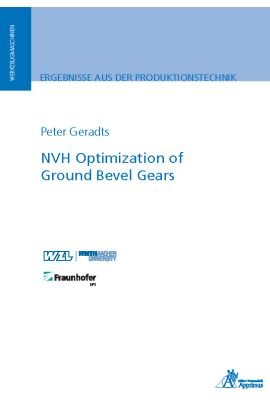Bevel gears are complex to design, and especially the control of the NVH behavior poses a challenge. The numerous input parameters and associated uncertainties lead to an iterative, expertise-driven design process of the micro geometry with many prototype variants and subsequent testing. The objective of this thesis is to provide a comprehensive design methodology which supports the design engineer to objectify the design process and to provide the best gear geometry under consideration of manufacturing and assembly tolerances as well as the load-dependent deflection values.
At first, the capability of the tooth contact analysis to simulate the loaded transmission error in the application-relevant magnitude is proven. The validation of the loaded transmission error was accomplished by the construction of a novel bevel gear fixture with the capability to measure the quasi-static loaded transmission error and the dynamic differential rotary acceleration close to the gear mesh.
The validation of the loaded tooth contact analysis is the basis for the multistep methodology for a robust bevel gear design considering bevel gear tolerances. The methodology is a combination of the loaded tooth contact analysis with scanning and statistical methods. The evaluation criteria for design variants are weighted depending on load-dependent design targets. Determination of the best design variants is achieved by scanning the solution space for the best variants with the best grades. The developed methodology is applied to a fictive production case for the bevel gear fixture. Within the validation of the methodology, parts were manufactured, and the loaded transmission error was measured. By introducing an additional, load-dependent relative spiral angle deviation in the loaded tooth contact analysis, a very good correlation for the amplitudes of the first four gear mesh harmonics over load was achieved.
Finally, as an additional optimization approach, instead of reducing the transmission error, a targeted manipulation of the transmission error composition was investigated. It is shown that a small topography variation from tooth to tooth reduces the amplitudes of the gear mesh harmonic excitation by spreading the excitation to adjacent non-integer gear mesh harmonic frequencies. The evaluation of the dynamic differential rotary acceleration for optimized variants confirmed a reduced tonality up to 60%, and the higher gear mesh harmonics were cancelled out.
| Autor | Geradts, Peter |
|---|---|
| Lieferzeit | 3-4 Tage |
| Gewicht | 0.226 kg |
| Erscheinungsdatum | 30.10.2019 |
Werkzeugmaschinen
NVH Optimization of Ground Bevel Gears
Kurzbeschreibung
Bevel gears are complex to design, and especially the control of the NVH behavior poses a challenge. The objective of this thesis is to provide a design methodology which supports the design engineer to objectify the design process and to provide the best gear geometry considering manufacturing and assembly tolerances as well as the load-dependent deflection values. Additionally, the targeted topography scatter is introduced to optimize the noise characteristic of gears by reducing tonality.

